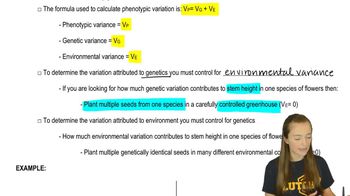Table of contents
- 1. Introduction to Genetics51m
- 2. Mendel's Laws of Inheritance3h 37m
- 3. Extensions to Mendelian Inheritance2h 41m
- 4. Genetic Mapping and Linkage2h 28m
- 5. Genetics of Bacteria and Viruses1h 21m
- 6. Chromosomal Variation1h 48m
- 7. DNA and Chromosome Structure56m
- 8. DNA Replication1h 10m
- 9. Mitosis and Meiosis1h 34m
- 10. Transcription1h 0m
- 11. Translation58m
- 12. Gene Regulation in Prokaryotes1h 19m
- 13. Gene Regulation in Eukaryotes44m
- 14. Genetic Control of Development44m
- 15. Genomes and Genomics1h 50m
- 16. Transposable Elements47m
- 17. Mutation, Repair, and Recombination1h 6m
- 18. Molecular Genetic Tools19m
- 19. Cancer Genetics29m
- 20. Quantitative Genetics1h 26m
- 21. Population Genetics50m
- 22. Evolutionary Genetics29m
20. Quantitative Genetics
Analyzing Trait Variance
Problem 22c
Textbook Question
Textbook QuestionSuppose a polygenic system for producing color in kernels of a grain is controlled by three additive genes, G, M, and T. There are two alleles of each gene, G₁ and G₂, M₁, and M₂, and T₁ and T₂. The phenotypic effects of the three genotypes of the G gene are G₁G₁ = 6 units of color, G₁G₂ = 3 units of color, and G₂G₂ = 1 unit of color. The phenotypic effects for genes M and T are similar, giving the phenotype of a plant with the genotype G₁G₁M₁M₁T₁T₁ a total of 18 units of color and a plant with the genotype G₂G₂M₂M₂T₂T₂ a total of 3 units of color. Assuming the threshold model applies to this kernel-color system, what proportion of the progeny of the cross G₁G₂M₁M₂T₂T₂xG₁G₂M₁M₂T₁T₂ do you expect to display colored kernels?
 Verified Solution
Verified SolutionThis video solution was recommended by our tutors as helpful for the problem above
Video duration:
5mPlay a video:
Was this helpful?
Key Concepts
Here are the essential concepts you must grasp in order to answer the question correctly.
Polygenic Inheritance
Polygenic inheritance refers to the genetic mechanism where multiple genes contribute to a single trait, resulting in a continuous range of phenotypes. In this case, three additive genes (G, M, and T) influence the color of the kernels, with each gene having two alleles that contribute additively to the overall phenotype. Understanding this concept is crucial for predicting the phenotypic outcomes of genetic crosses involving multiple genes.
Recommended video:
Guided course

Organelle Inheritance
Additive Gene Effects
Additive gene effects occur when the contributions of different alleles combine to produce a cumulative effect on the phenotype. For example, in the given scenario, the G gene has different phenotypic effects based on its genotype, with G₁G₁ contributing the most color units. Recognizing how these additive effects work allows for the calculation of total phenotypic expression based on the genotypes of the parents in the cross.
Recommended video:
Guided course

Maternal Effect
Threshold Model
The threshold model in genetics posits that a certain cumulative effect of alleles must be reached before a specific phenotype is expressed. In the context of the kernel color system, this model suggests that only progeny that surpass a certain threshold of color units will display colored kernels. This concept is essential for determining the proportion of progeny exhibiting the desired phenotype based on the genotypes involved in the cross.
Recommended video:
Guided course

Step 6

 8:34m
8:34mWatch next
Master Analyzing Trait Variance with a bite sized video explanation from Kylia Goodner
Start learningRelated Videos
Related Practice


